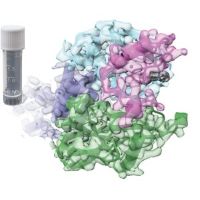Specification
| Organism | Influenza A virus (strain A/Hickox/1940 H1N1) |
| Expression Host | Yeast |
| Tag Info | N-terminal 6xHis-tagged |
| Purity | Greater than 85% by SDS-PAGE |
| Uniprot ID | Q0HD54 |
| Gene Names | NS |
| Alternative Names | NS1A |
| Expression Region | Full Length(1-237aa ) |
| Molecular Weight | 28.8 kDa |
| Protein Sequence | MDPNTVSSFQVDCFLWHVRKRVADQELGDAPFLDRLRRDQKSLKGRGSTLGLNIETATRVGKQIVERILKEESDEALKMTMASAPASRYLTDMTIEEMSRDWFMLMPKQKVAGPLCIRMDQAVMDKSIILKANFSVIFDRLETLILLRAFTEEGAIVGEISPLPSLPGHTNEDVKNAIGVLIGGLEWNDNTVRVSKTLQRFAWRSSNENGGPPLTPKQKRKMARTIRSEVRRNKMVD |
| Form | Liquid or Lyophilization |
| Buffer | The default storage buffer is Tris/PBS-based buffer, 5%-50% glycerol if the delivery form is liquid. The lyophilization buffer is Tris/PBS-based buffer, 6% Trehalose, pH 8.0 if the delivery form is lyophilized powder. Please contact us if you have any special requirment. |
| Reconstitution | Please reconstitute protein in deionized sterile water and we recommend that briefly centrifuge thevial prior to opening the vial .We recommend aliquot for long-term storage at -20℃/-80℃. |
Background
| Relevance | Prevents the establishment of the cellular antiviral state by inhibiting TRIM25-mediated DDX58 ubiquitination, which normally triggers the antiviral transduction signal that leads to the activation of type I IFN genes by transcription factors IRF3 and IRF7. Prevents human EIF2AK2/PKR activation, either by binding double-strand RNA, or by interacting directly with EIF2AK2/PKR. This function may be important at the very beginning of the infection, when NS1 is mainly present in the cytoplasm. Also binds poly(A) and U6 snRNA. Inhibits post-transcriptional processing of cellular pre-mRNA, by binding and inhibiting two cellular proteins that are required for the 3'-end processing of cellular pre-mRNAs: the 30KDA cleavage and polyadenylation specificity factor/CPSF4 and the poly(A)-binding protein 2/PABPN1. In turn, unprocessed 3' end pre-mRNAs accumulate in the host nucleus and are no longer exported to the cytoplasm. Cellular protein synthesis is thereby shut off very early after virus infection. Viral protein synthesis is not affected by the inhibition of the cellular 3' end processing machinery because the poly(A) tails of viral mRNAs are produced by the viral polymerase through a stuttering mechanism. |
| Involvement in Disease | |
| Subcellular Location | Host nucleus, Host cytoplasm |
| Protein Families | Influenza A viruses NS1 family |
| Tissue Specificity | NS |
QC Data
| Note | Please contact us for QC Data |
| Product Image (Reference Only) |  |

